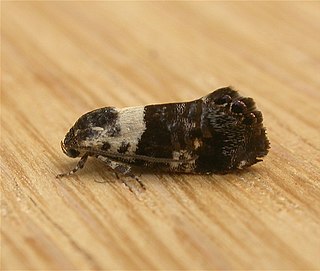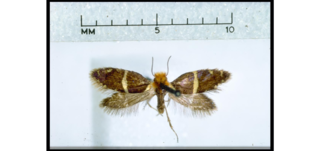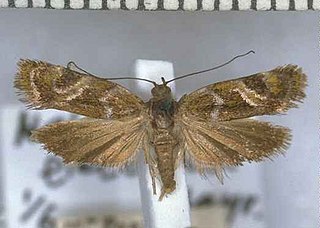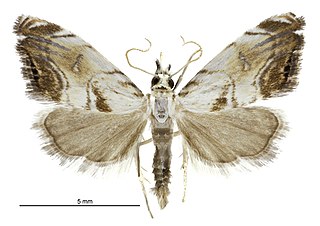
Crambus pratella is a species of moth of the family Crambidae. It is found in Europe and Asia Minor.

Eupselia aristonica is a species of moth of the family Depressariidae. It is found in Australia, where it has been recorded from New South Wales, the Australian Capital Territory, Victoria and Tasmania.

Gillmeria pallidactyla is a moth of the family Pterophoridae first described by the English entomologist, Adrian Hardy Haworth in 1811. It has a Holarctic distribution and is widespread throughout North America and the Palearctic.

Grapholita compositella, the clover seed moth, is a moth of the family Tortricidae. It is found from Europe to Asia Minor, Mongolia, China and eastern Russia. It is also present in North America.

Sabatinca ianthina is a species of moth belonging to the family Micropterigidae. It was described by Alfred Philpott in 1921. It is endemic to New Zealand. This species can be found on both the North and the South Islands from the Hawkes Bay down to Westland. The adults of this species are on the wing from the end of September until the middle of December. Although this species resembles Zealandopterix zonodoxa, S. ianthina is a larger moth and the range of the two species only overlaps in White Pine Bush Scenic Reserve in the Hawke’s Bay.

Lichenaula lichenea is a species of moth of the family Xyloryctidae. It is known in Australia from the Australian Capital Territory, New South Wales and Queensland.

Glaucocharis chrysochyta is a species of moth in the family Crambidae. This species was first described by Edward Meyrick in 1882. It is endemic to New Zealand and is found throughout the country. It inhabits native forest. Larvae appear to feed on moss and likely pupate there. Adult moths are on the wing from November to March. They fly at night and are attracted to light.

Cosmopterix molybdina is a moth of the family Cosmopterigidae. It is known from the United States and Canada.

Glyphipterix equitella is a moth of the family Glyphipterigidae. It is found from Fennoscandia to the Iberian Peninsula, Sardinia, Sicily and Crete and from Ireland to Romania.

Grapholita janthinana, the hawthorn leafroller, is a moth of the family Tortricidae. It was described by Philogène Auguste Joseph Duponchel in 1843. It is found in most of Europe, except most of the Balkan Peninsula, Ukraine, Lithuania and Estonia. The habitat consists of hedgerows, gardens and woodland edges.

Hierodoris electrica is a moth of the family Oecophoridae. It was described by Edward Meyrick in 1889. It is endemic to New Zealand, where it has been reported from the northern and southern parts of the South Island. The larva of H. electrica has yet to be described. The wingspan is between 15 and 16.5 mm. The ground colour of the forewings is dark brown, with narrow yellow scales overlaying this base colour. The hindwings are brown. The known larval host species is Olearia nummulariifolia.

Pammene populana, the pygmy piercer, is a species of moth of the family Tortricidae. It is found in most of Europe, except Portugal, the Balkan Peninsula and Ukraine. The habitat consists of woodland, marshes, riverbanks, fens and sand dunes.

Glaucocharis harmonica is a moth in the family Crambidae. This species was described by Edward Meyrick in 1888. It is endemic to New Zealand and is found in the North and South Islands. It inhabits lowland to subalpine native forest. It has been hypothesised that there are two broods per year. The larval hosts are unknown. Adults are on the wing from October until January.

Pyrgotis plinthoglypta is a species of moth of the family Tortricidae. It is endemic to New Zealand and is found throughout the whole country. The preferred habitat of this species is native forest. The larvae of this species feeds on rimu leaves from under a silken web. It pupates in loose cocoons amongst rimu foliage. Adults are on the wing from October to May and are night flying. They are attracted to light and can be collected by beating their host tree. The adult insect resembles a small dried fragment of rimu foliage when at rest.
Polyhymno alcimacha is a moth of the family Gelechiidae. It was described by Edward Meyrick in 1918. It is found in India, where it has been recorded from Coimbatore in the south and Assam.
Comotechna scutulata is a moth in the family Depressariidae. It was described by Edward Meyrick in 1921. It is found in Brazil.

Epinotia subocellana is a species of moth of the family Tortricidae. It is found in Asia and Europe and was first described by Edward Donovan in 1806.

Epiblema costipunctana is a species of moth belonging to the family Tortricidae. It is native to Europe.

Tingena siderota is a species of moth in the family Oecophoridae. It is endemic to New Zealand and has been observed at Mount Arthur, Arthur's Pass and in the Hawkes Bay. The adults of this species are on the wing in January and are said to be abundant on the flowers of species in the genus Aciphylla.

Holocola charopa is a species of moth in the family Tortricidae. It was first described by Edward Meyrick in 1888. It is endemic to New Zealand and has been observed in the northern parts of the North Island. The larvae web together and feed on the new shoots of their host plant Kunzea ericoides. Adults are on the wing in July and from November until February.



















